coolant temperature DODGE DAKOTA 2009 3.G Owners Manual
[x] Cancel search | Manufacturer: DODGE, Model Year: 2009, Model line: DAKOTA, Model: DODGE DAKOTA 2009 3.GPages: 449, PDF Size: 10.96 MB
Page 170 of 449
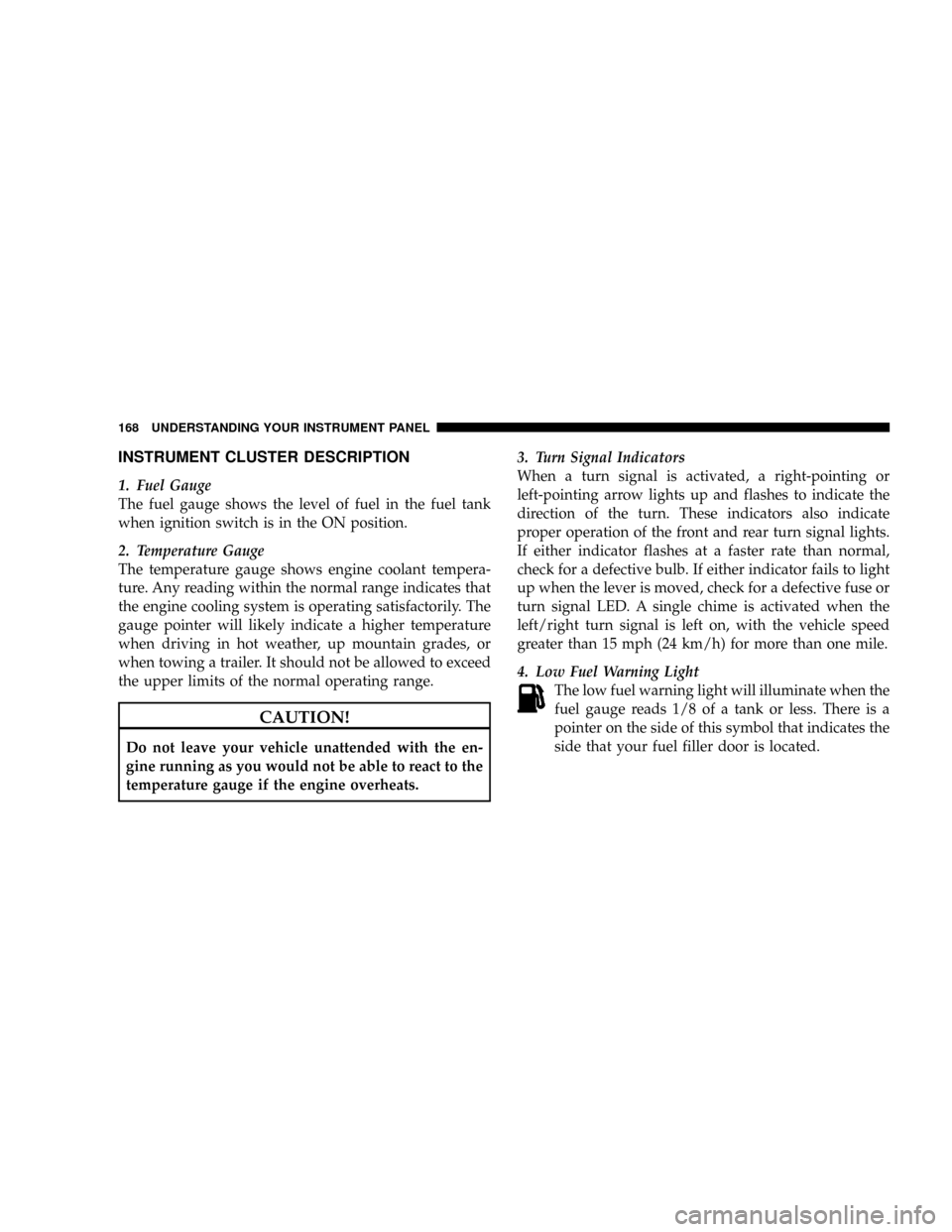
INSTRUMENT CLUSTER DESCRIPTION
1. Fuel Gauge
The fuel gauge shows the level of fuel in the fuel tank
when ignition switch is in the ON position.
2. Temperature Gauge
The temperature gauge shows engine coolant tempera-
ture. Any reading within the normal range indicates that
the engine cooling system is operating satisfactorily. The
gauge pointer will likely indicate a higher temperature
when driving in hot weather, up mountain grades, or
when towing a trailer. It should not be allowed to exceed
the upper limits of the normal operating range.
CAUTION!
Do not leave your vehicle unattended with the en-
gine running as you would not be able to react to the
temperature gauge if the engine overheats.3. Turn Signal Indicators
When a turn signal is activated, a right-pointing or
left-pointing arrow lights up and flashes to indicate the
direction of the turn. These indicators also indicate
proper operation of the front and rear turn signal lights.
If either indicator flashes at a faster rate than normal,
check for a defective bulb. If either indicator fails to light
up when the lever is moved, check for a defective fuse or
turn signal LED. A single chime is activated when the
left/right turn signal is left on, with the vehicle speed
greater than 15 mph (24 km/h) for more than one mile.
4. Low Fuel Warning Light
The low fuel warning light will illuminate when the
fuel gauge reads 1/8 of a tank or less. There is a
pointer on the side of this symbol that indicates the
side that your fuel filler door is located.
168 UNDERSTANDING YOUR INSTRUMENT PANEL
Page 235 of 449
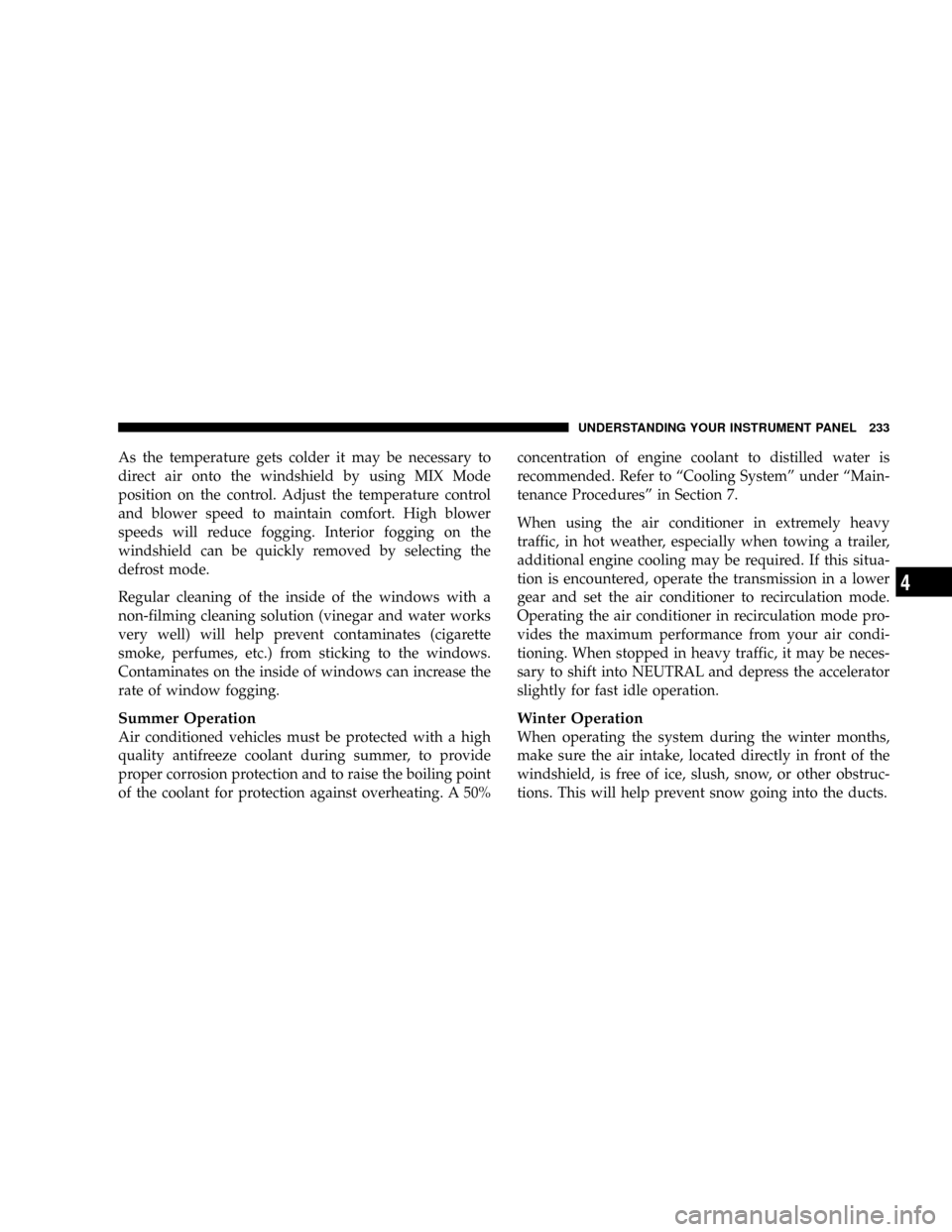
As the temperature gets colder it may be necessary to
direct air onto the windshield by using MIX Mode
position on the control. Adjust the temperature control
and blower speed to maintain comfort. High blower
speeds will reduce fogging. Interior fogging on the
windshield can be quickly removed by selecting the
defrost mode.
Regular cleaning of the inside of the windows with a
non-filming cleaning solution (vinegar and water works
very well) will help prevent contaminates (cigarette
smoke, perfumes, etc.) from sticking to the windows.
Contaminates on the inside of windows can increase the
rate of window fogging.
Summer Operation
Air conditioned vehicles must be protected with a high
quality antifreeze coolant during summer, to provide
proper corrosion protection and to raise the boiling point
of the coolant for protection against overheating. A 50%concentration of engine coolant to distilled water is
recommended. Refer to ªCooling Systemº under ªMain-
tenance Proceduresº in Section 7.
When using the air conditioner in extremely heavy
traffic, in hot weather, especially when towing a trailer,
additional engine cooling may be required. If this situa-
tion is encountered, operate the transmission in a lower
gear and set the air conditioner to recirculation mode.
Operating the air conditioner in recirculation mode pro-
vides the maximum performance from your air condi-
tioning. When stopped in heavy traffic, it may be neces-
sary to shift into NEUTRAL and depress the accelerator
slightly for fast idle operation.
Winter Operation
When operating the system during the winter months,
make sure the air intake, located directly in front of the
windshield, is free of ice, slush, snow, or other obstruc-
tions. This will help prevent snow going into the ducts.
UNDERSTANDING YOUR INSTRUMENT PANEL 233
4
Page 250 of 449
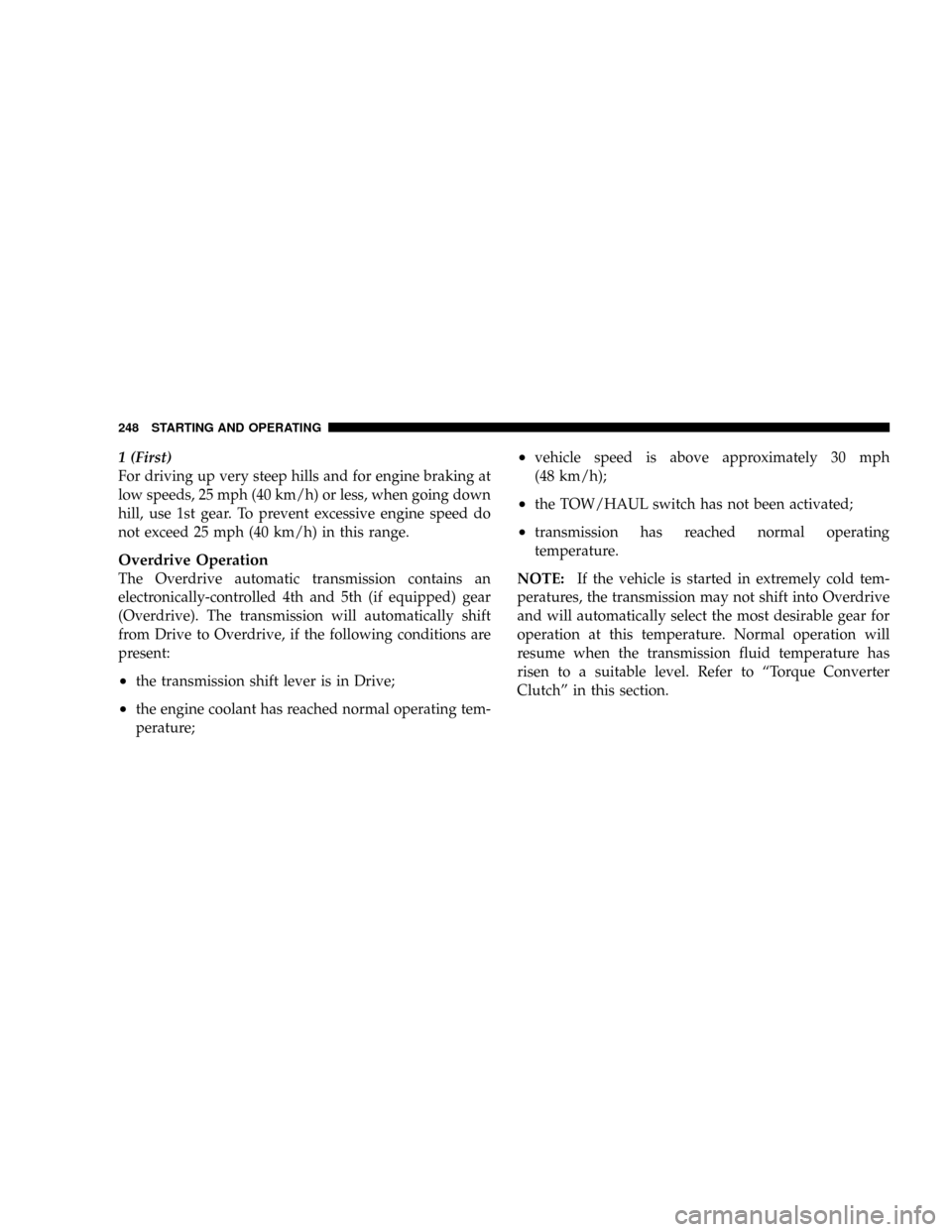
1 (First)
For driving up very steep hills and for engine braking at
low speeds, 25 mph (40 km/h) or less, when going down
hill, use 1st gear. To prevent excessive engine speed do
not exceed 25 mph (40 km/h) in this range.
Overdrive Operation
The Overdrive automatic transmission contains an
electronically-controlled 4th and 5th (if equipped) gear
(Overdrive). The transmission will automatically shift
from Drive to Overdrive, if the following conditions are
present:
²the transmission shift lever is in Drive;
²the engine coolant has reached normal operating tem-
perature;
²vehicle speed is above approximately 30 mph
(48 km/h);
²the TOW/HAUL switch has not been activated;
²transmission has reached normal operating
temperature.
NOTE:If the vehicle is started in extremely cold tem-
peratures, the transmission may not shift into Overdrive
and will automatically select the most desirable gear for
operation at this temperature. Normal operation will
resume when the transmission fluid temperature has
risen to a suitable level. Refer to ªTorque Converter
Clutchº in this section.
248 STARTING AND OPERATING
Page 368 of 449
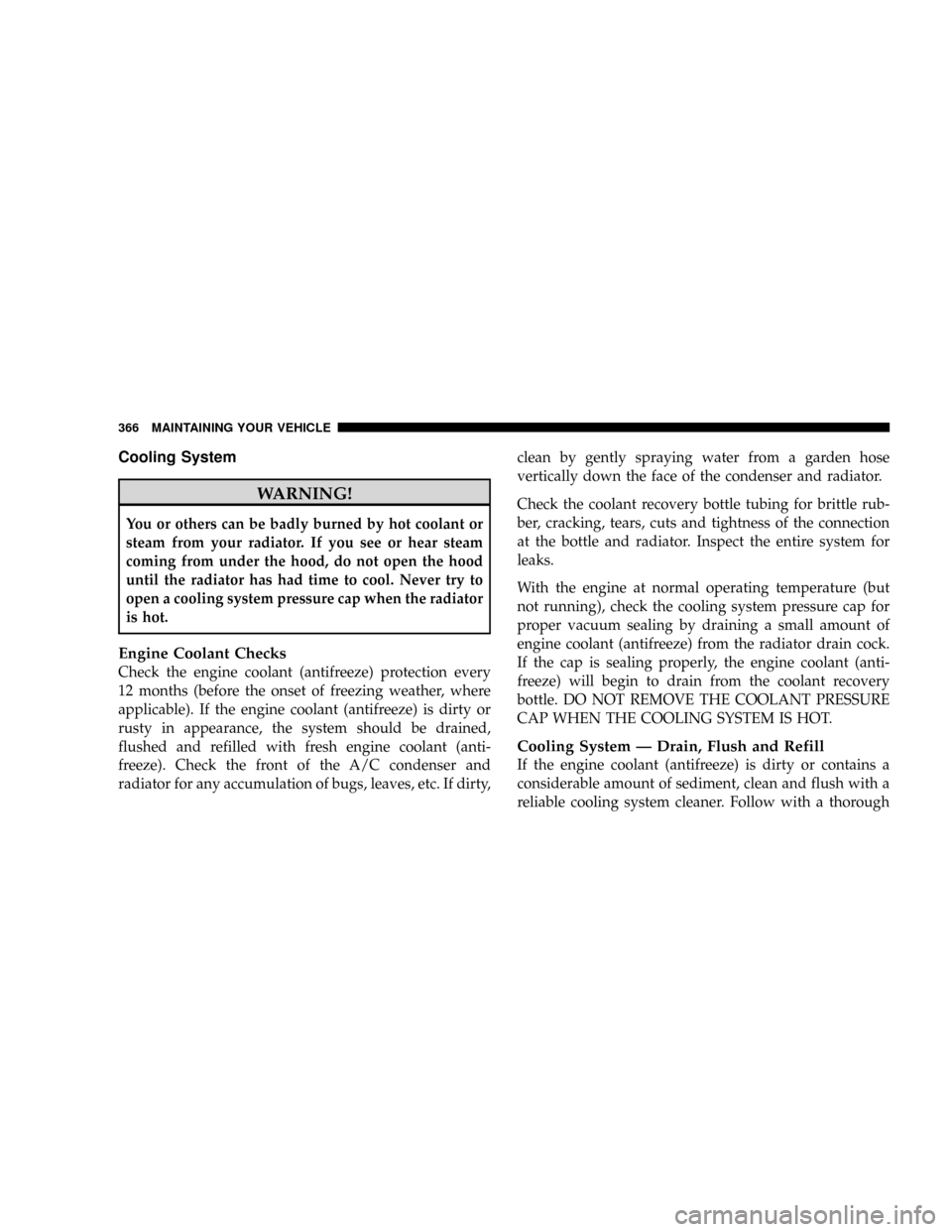
Cooling System
WARNING!
You or others can be badly burned by hot coolant or
steam from your radiator. If you see or hear steam
coming from under the hood, do not open the hood
until the radiator has had time to cool. Never try to
open a cooling system pressure cap when the radiator
is hot.
Engine Coolant Checks
Check the engine coolant (antifreeze) protection every
12 months (before the onset of freezing weather, where
applicable). If the engine coolant (antifreeze) is dirty or
rusty in appearance, the system should be drained,
flushed and refilled with fresh engine coolant (anti-
freeze). Check the front of the A/C condenser and
radiator for any accumulation of bugs, leaves, etc. If dirty,clean by gently spraying water from a garden hose
vertically down the face of the condenser and radiator.
Check the coolant recovery bottle tubing for brittle rub-
ber, cracking, tears, cuts and tightness of the connection
at the bottle and radiator. Inspect the entire system for
leaks.
With the engine at normal operating temperature (but
not running), check the cooling system pressure cap for
proper vacuum sealing by draining a small amount of
engine coolant (antifreeze) from the radiator drain cock.
If the cap is sealing properly, the engine coolant (anti-
freeze) will begin to drain from the coolant recovery
bottle. DO NOT REMOVE THE COOLANT PRESSURE
CAP WHEN THE COOLING SYSTEM IS HOT.
Cooling System Ð Drain, Flush and Refill
If the engine coolant (antifreeze) is dirty or contains a
considerable amount of sediment, clean and flush with a
reliable cooling system cleaner. Follow with a thorough
366 MAINTAINING YOUR VEHICLE
Page 370 of 449
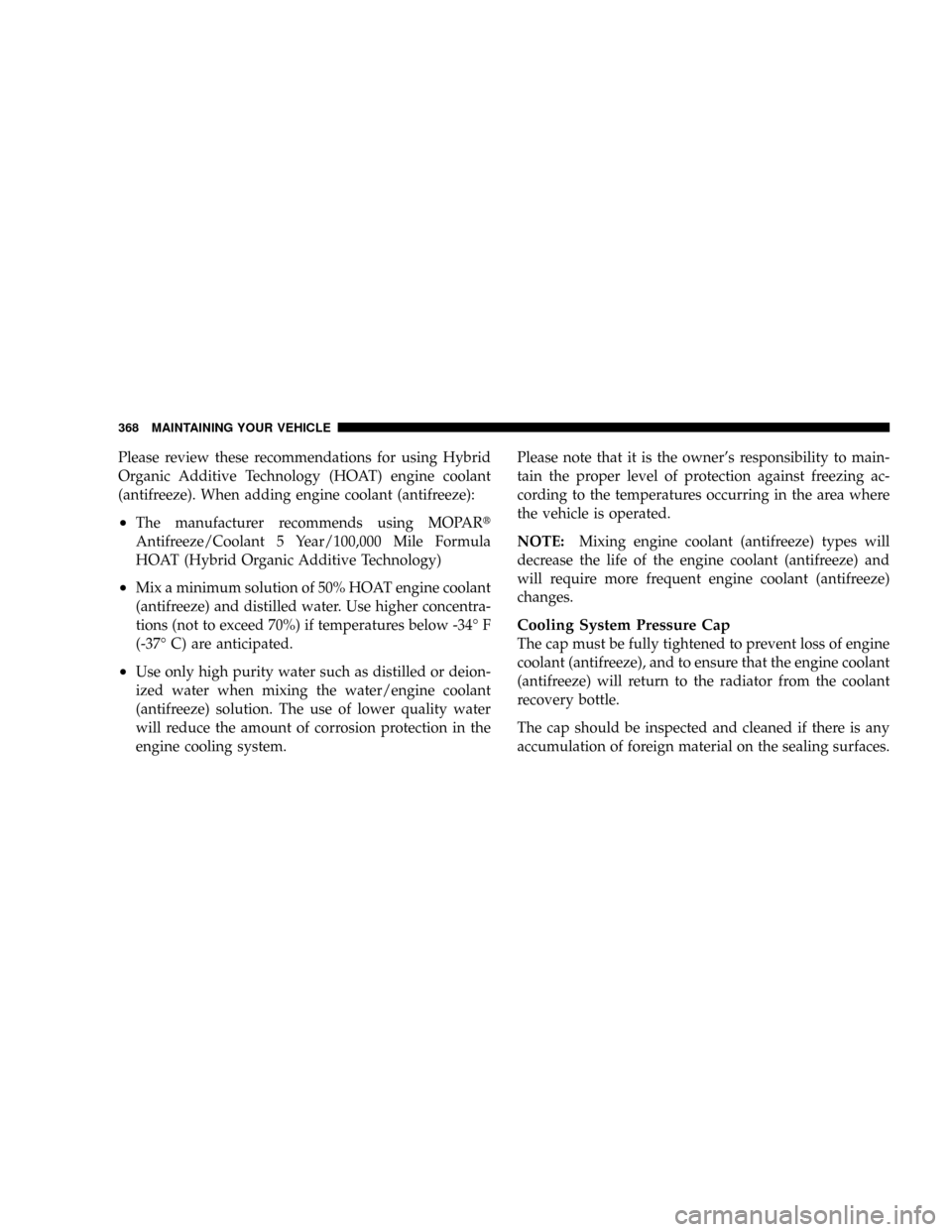
Please review these recommendations for using Hybrid
Organic Additive Technology (HOAT) engine coolant
(antifreeze). When adding engine coolant (antifreeze):
²The manufacturer recommends using MOPARt
Antifreeze/Coolant 5 Year/100,000 Mile Formula
HOAT (Hybrid Organic Additive Technology)
²Mix a minimum solution of 50% HOAT engine coolant
(antifreeze) and distilled water. Use higher concentra-
tions (not to exceed 70%) if temperatures below -34É F
(-37É C) are anticipated.
²Use only high purity water such as distilled or deion-
ized water when mixing the water/engine coolant
(antifreeze) solution. The use of lower quality water
will reduce the amount of corrosion protection in the
engine cooling system.Please note that it is the owner's responsibility to main-
tain the proper level of protection against freezing ac-
cording to the temperatures occurring in the area where
the vehicle is operated.
NOTE:Mixing engine coolant (antifreeze) types will
decrease the life of the engine coolant (antifreeze) and
will require more frequent engine coolant (antifreeze)
changes.
Cooling System Pressure Cap
The cap must be fully tightened to prevent loss of engine
coolant (antifreeze), and to ensure that the engine coolant
(antifreeze) will return to the radiator from the coolant
recovery bottle.
The cap should be inspected and cleaned if there is any
accumulation of foreign material on the sealing surfaces.
368 MAINTAINING YOUR VEHICLE
Page 372 of 449
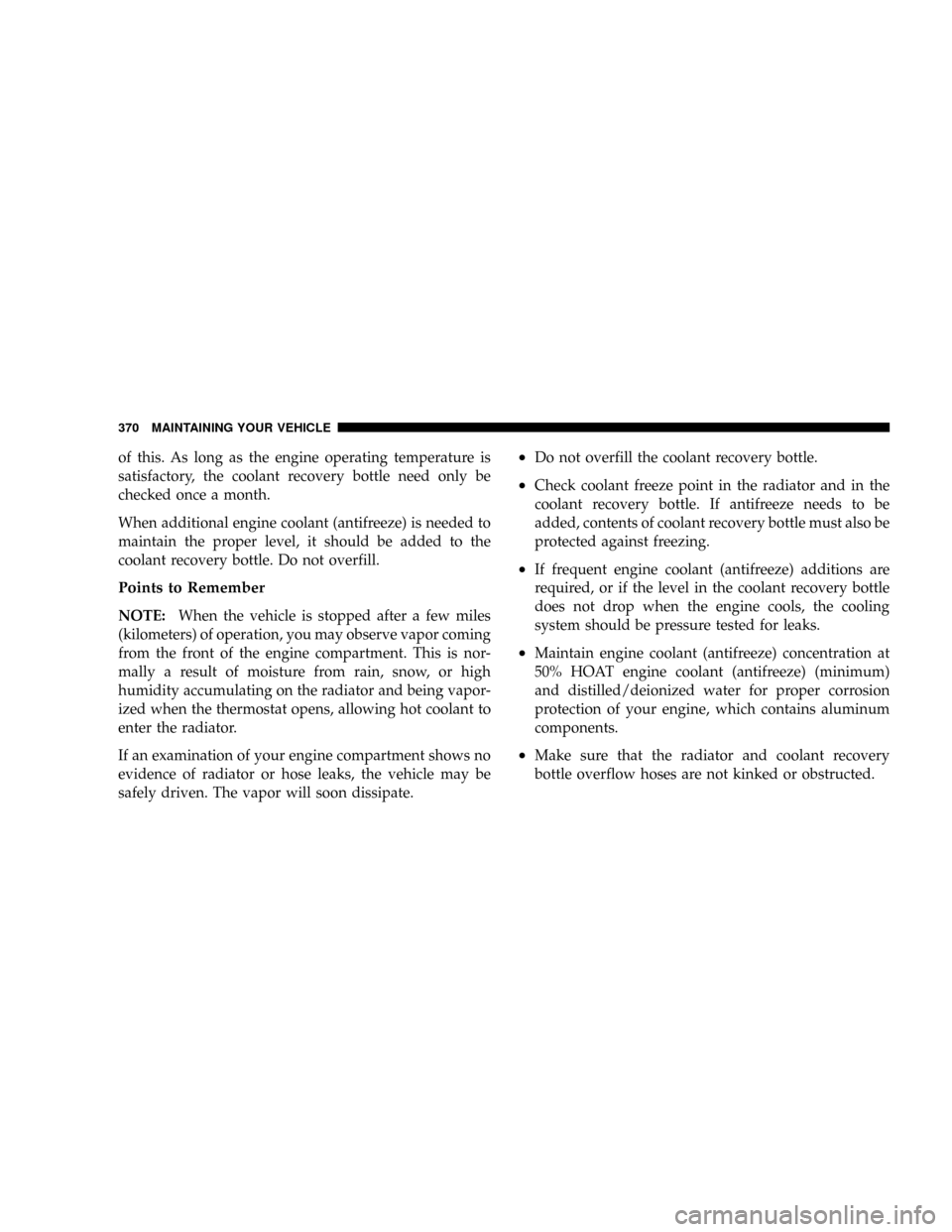
of this. As long as the engine operating temperature is
satisfactory, the coolant recovery bottle need only be
checked once a month.
When additional engine coolant (antifreeze) is needed to
maintain the proper level, it should be added to the
coolant recovery bottle. Do not overfill.
Points to Remember
NOTE:When the vehicle is stopped after a few miles
(kilometers) of operation, you may observe vapor coming
from the front of the engine compartment. This is nor-
mally a result of moisture from rain, snow, or high
humidity accumulating on the radiator and being vapor-
ized when the thermostat opens, allowing hot coolant to
enter the radiator.
If an examination of your engine compartment shows no
evidence of radiator or hose leaks, the vehicle may be
safely driven. The vapor will soon dissipate.
²Do not overfill the coolant recovery bottle.
²Check coolant freeze point in the radiator and in the
coolant recovery bottle. If antifreeze needs to be
added, contents of coolant recovery bottle must also be
protected against freezing.
²If frequent engine coolant (antifreeze) additions are
required, or if the level in the coolant recovery bottle
does not drop when the engine cools, the cooling
system should be pressure tested for leaks.
²Maintain engine coolant (antifreeze) concentration at
50% HOAT engine coolant (antifreeze) (minimum)
and distilled/deionized water for proper corrosion
protection of your engine, which contains aluminum
components.
²Make sure that the radiator and coolant recovery
bottle overflow hoses are not kinked or obstructed.
370 MAINTAINING YOUR VEHICLE
Page 432 of 449
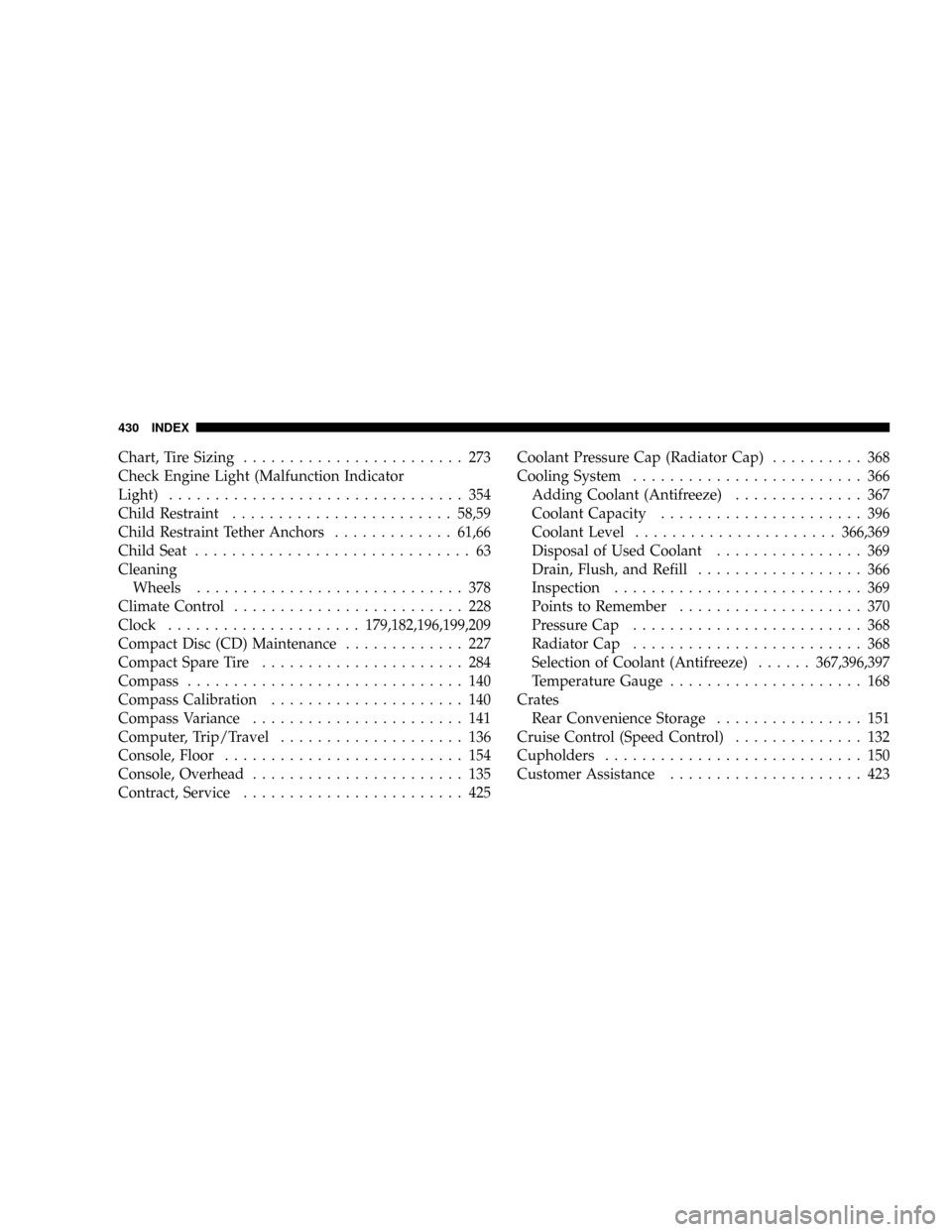
Chart, Tire Sizing........................ 273
Check Engine Light (Malfunction Indicator
Light)................................ 354
Child Restraint........................58,59
Child Restraint Tether Anchors.............61,66
Child Seat.............................. 63
Cleaning
Wheels............................. 378
Climate Control......................... 228
Clock.....................179,182,196,199,209
Compact Disc (CD) Maintenance............. 227
Compact Spare Tire...................... 284
Compass.............................. 140
Compass Calibration..................... 140
Compass Variance....................... 141
Computer, Trip/Travel.................... 136
Console, Floor.......................... 154
Console, Overhead....................... 135
Contract, Service........................ 425Coolant Pressure Cap (Radiator Cap).......... 368
Cooling System......................... 366
Adding Coolant (Antifreeze).............. 367
Coolant Capacity...................... 396
Coolant Level......................366,369
Disposal of Used Coolant................ 369
Drain, Flush, and Refill.................. 366
Inspection........................... 369
Points to Remember.................... 370
Pressure Cap......................... 368
Radiator Cap......................... 368
Selection of Coolant (Antifreeze)......367,396,397
Temperature Gauge..................... 168
Crates
Rear Convenience Storage................ 151
Cruise Control (Speed Control).............. 132
Cupholders............................ 150
Customer Assistance..................... 423
430 INDEX
Page 435 of 449
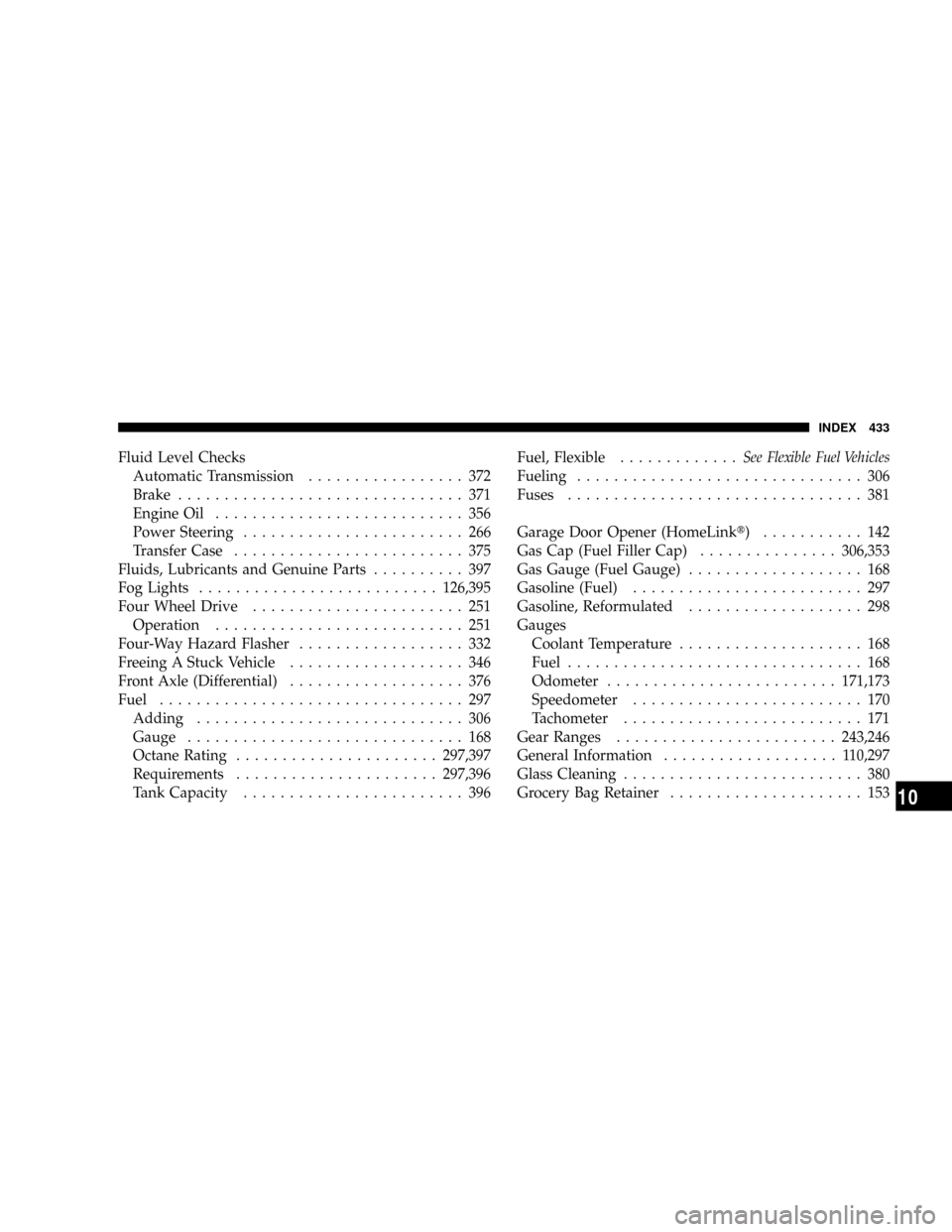
Fluid Level Checks
Automatic Transmission................. 372
Brake............................... 371
Engine Oil........................... 356
Power Steering........................ 266
Transfer Case......................... 375
Fluids, Lubricants and Genuine Parts.......... 397
Fog Lights..........................126,395
Four Wheel Drive....................... 251
Operation........................... 251
Four-Way Hazard Flasher.................. 332
Freeing A Stuck Vehicle................... 346
Front Axle (Differential)................... 376
Fuel................................. 297
Adding............................. 306
Gauge.............................. 168
Octane Rating......................297,397
Requirements......................297,396
Tank Capacity........................ 396Fuel, Flexible.............See Flexible Fuel Vehicles
Fueling............................... 306
Fuses................................ 381
Garage Door Opener (HomeLinkt) ........... 142
Gas Cap (Fuel Filler Cap)...............306,353
Gas Gauge (Fuel Gauge)................... 168
Gasoline (Fuel)......................... 297
Gasoline, Reformulated................... 298
Gauges
Coolant Temperature.................... 168
Fuel................................ 168
Odometer.........................171,173
Speedometer......................... 170
Tachometer.......................... 171
Gear Ranges........................243,246
General Information................... 110,297
Glass Cleaning.......................... 380
Grocery Bag Retainer..................... 153
INDEX 433
10
Page 443 of 449
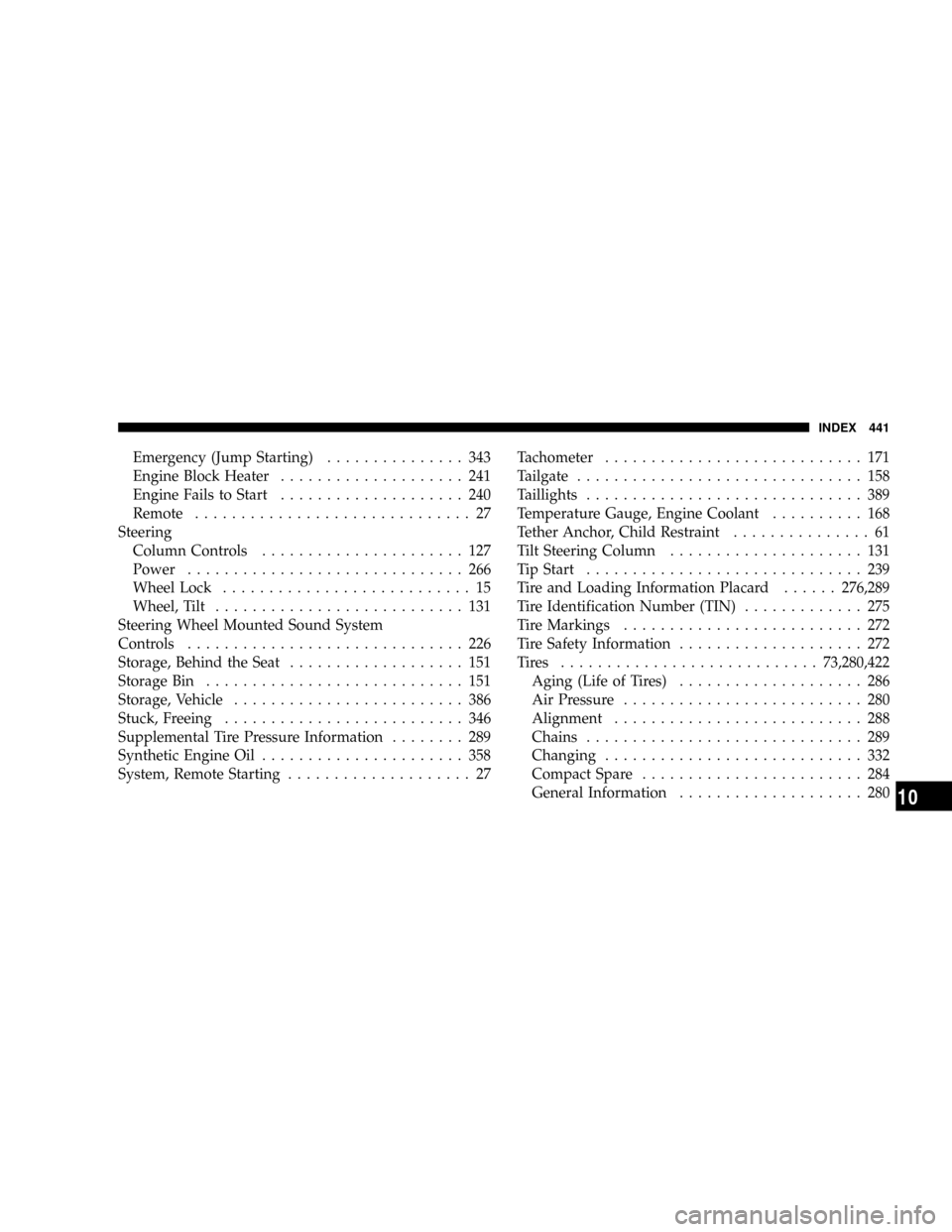
Emergency (Jump Starting)............... 343
Engine Block Heater.................... 241
Engine Fails to Start.................... 240
Remote.............................. 27
Steering
Column Controls...................... 127
Power.............................. 266
Wheel Lock........................... 15
Wheel, Tilt........................... 131
Steering Wheel Mounted Sound System
Controls.............................. 226
Storage, Behind the Seat................... 151
Storage Bin............................ 151
Storage, Vehicle......................... 386
Stuck, Freeing.......................... 346
Supplemental Tire Pressure Information........ 289
Synthetic Engine Oil...................... 358
System, Remote Starting.................... 27Tachometer............................ 171
Tailgate............................... 158
Taillights.............................. 389
Temperature Gauge, Engine Coolant.......... 168
Tether Anchor, Child Restraint............... 61
Tilt Steering Column..................... 131
Tip Start.............................. 239
Tire and Loading Information Placard......276,289
Tire Identification Number (TIN)............. 275
Tire Markings.......................... 272
Tire Safety Information.................... 272
Tires ............................73,280,422
Aging (Life of Tires).................... 286
Air Pressure.......................... 280
Alignment........................... 288
Chains.............................. 289
Changing............................ 332
Compact Spare........................ 284
General Information.................... 280
INDEX 441
10